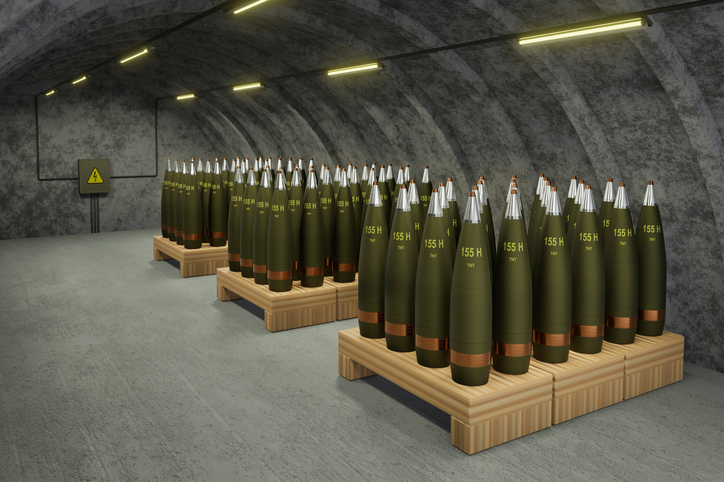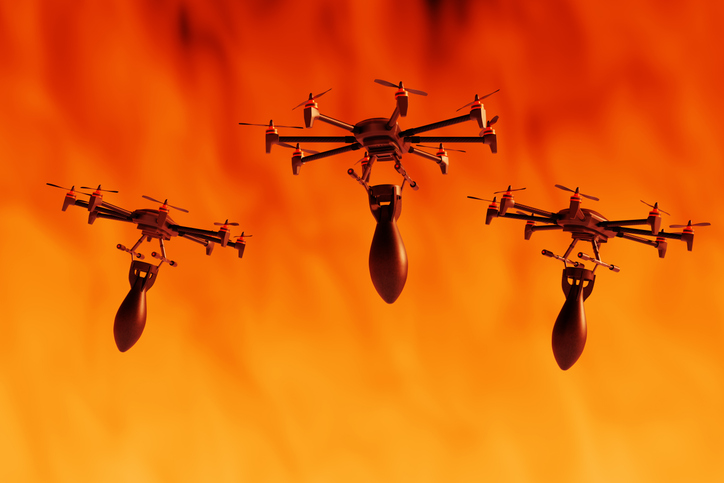As the nature of warfare transforms, creative solutions and strategic foresight will be at the heart of military readiness and resilience.
Three months into 2024, we’re traversing a world where conflicts intensify, and uncertainty seamlessly intertwines with our daily lives. The wars in Ukraine and Israel present a stark departure from those of yesterday. What we witness now is a marked escalation in operational tempo, coupled with the widespread adoption of cutting-edge technologies by opposing factions. This transformative shift disrupts established paradigms, challenging the notion that sheer mass and technology alone dictate the outcomes of conflicts. Rapid evolutions in tactics, technology, and operational strategies are underway; the prospect of de-escalation seems distant and is overshadowed by accelerated rearmament. This article considers some key factors that are shaping the evolving defense landscape.
Artillery Shell Shortfall: Ukraine’s Need Unmet Without Diversification and Creative Solutions

The Russo-Ukrainian conflict witnessed a level of artillery usage reminiscent of the World Wars. Ukraine’s consumption exceeds 200,000 artillery rounds per month, while Russia’s demand could be four times as high. Recognizing its need for support, Ukraine appealed to the European Union to provide 250,000 shells monthly. Although Europe’s shell manufacturing capacity remains confidential, reports from February 2023 suggested the continent could, at that time, produce approximately 230,000 shells annually. Efforts to bolster manufacturing capacity, such as Rheinmetall’s acquisition of Expal Systems and BAE System’s shift to 24-hour working in the UK ammunition factories have yielded some production gains. Nevertheless, even an optimistic estimate of Europe’s production capacity in January 2024— perhaps 600,000 shells per year — falls significantly short of Ukraine’s estimated annual requirement of 1.5 million shells for defense and counteroffensive operations. Meanwhile, the EU’s 2023 plan to supply Ukraine with 1 million shells by spring 2024 is slipping, appearing increasingly unachievable.
Across the Atlantic, the US currently has a monthly shell production capacity of approximately 30,000 units, a figure projected to double by summer 2024 and potentially reach 100,000 units per month by the end of 2025. This increased capacity is poised to be divided between supplying Israel and Ukraine. However, even under the most favorable circumstances, the combined efforts of the US and Europe are unlikely to meet Ukraine’s ammunition demands in 2024. This consideration arises from the fact that supplying nations will also need to replenish their strategic reserves.
The solution to this supply shortfall is three-fold. Supplies from elsewhere – South Asia, Eastern Europe, and South America – may have to be tapped to meet requirements. This is challenging because of geopolitical complexities, and the desire of some suppliers to remain nonaligned. The second possibility is to ramp up production speed by reducing manufacturing tolerances and storage features that don’t compromise safety; not every shell needs to be machined to perfection especially if the majority are used for shelling to deter advances as opposed to targeted strikes. The third option is to supplement artillery with alternatives – take a dumb bomb, and make it smart by strapping on a guidance kit and a propulsion system, whilst ensuring that these can be launched from some of the missile launchers already used by Ukraine. This option is prohibitively expensive for a mass-firepower option but provides better range and precision, and most importantly there are plenty of dumb bombs lying around for repurposing. These measures may have to be accelerated to keep fighting.
Accelerating Pursuit of Global Positioning System (GPS) Alternatives Worldwide
The Ukrainian war illuminated one of the major drawbacks of technology-enabled warfare – the overreliance on Global Navigation Satellite Systems (GNSS) for positioning, navigation, and timing (PNT); whether it’s a software-defined radio used by a solider or a $ 4 million tomahawk missile, these equipment rely on the US GPS version of GNSS to ensure proper function. In Ukraine, guided munitions such as the US Excalibur shell were thrown off course, and battlefield situational awareness systems were rendered inoperative because of powerful Russian jamming. As a result, countries are accelerating research and development (R&D) into the development of better alternatives. Japan is strengthening its indigenous GNSS constellation and making it less GPS-dependent to operate. The US is building its constellation of small satellites to supplement GPS (a larger number of small satellites is harder to knock out than a smaller number of large satellites). There are also ongoing efforts to make new GNSS signals several hundred times stronger than the GPS signal, potentially making it harder to jam.
Governments are also turning to other technologies such as atomic clocks to ensure that the “timing and synchronization” component of their billion-dollar equipment does not get disrupted. Disrupted timing would mean diminished operational synchronization, targeting errors, and loss of data integrity and encryption during communication. While the atomic clocks of old were large and cumbersome devices, they have been successfully miniaturized to the size of a microchip today (chip-scale atomic clocks). These are still prohibitively expensive, but countries like the UK and the US are investing in making them cheaper and better. In the future, they are likely to be ubiquitous in most defense paraphernalia.
Older technology such as topographical mapping that uses visual images for guidance in cruise missiles and similar equipment are also being reinvigorated using Artificial Intelligence (AI) to make them more effective. AI-driven software that tracks real-time visuals (captured via an electro-optic camera) and compares them to reference sets can help in better targeting, routing, or geo-location if GNSS signals fail. Another technology area that could provide answers to this quest for GPS independence is quantum sensing. For example, in 2023, the Massachusetts Institute of Technology (MIT), the Air Force Research Laboratory (AFRL), and the Air Mobility Command jointly developed an aircraft-based based quantum-magnetometer that could detect minute variations in the earth’s magnetic field to pinpoint location without GPS. Many of these new developments are dual-use (commercial and defense) and stemming from universities and startups.
Saturation of Unmanned and Counter Unmanned Systems
Unmanned systems revolutionized warfare, bolstering Western superiority in numerous conflicts throughout this century. However, the Predators and Reapers of the world were only accessible to the US and its allies because of both the cost and complexity of maintaining and operating. These platforms were smart weapons for strategic and precision strikes.
Drone use in the Ukraine has transformed this position. Volume attacks from cheap first-person view (FPV) drones have replaced targeted drone strikes from long ranges. The drone that you would carry on a holiday to film some scenic views has been modified, strapped with explosives, and is being deftly maneuvered into tank hatches. Million-dollar equipment is being put out of commission by drones that cost a few thousand dollars or even less. As an example, Ukraine reported that they destroyed and damaged 428 pieces of Russian equipment during the week of 9-15 October, including 101 howitzers, 88 armored vehicles, and 75 tanks.
So how do you counter a swarm of small drones hurtling towards you that will explode on impact?
The logical answer points to jamming – creating a bubble of electromagnetic interference that disrupts their control signals, causing these drones to drop like flies. This seems like a straightforward countermeasure, but thanks to technological advances even this could prove difficult. Deploying miniaturized AI chips at the “edge” – within these drones, will make them more resilient. The AI will use imagery to identify targets for the kamikaze drone to perform its act of final service – “terminal targeting.” Some new FPV drones also come with swappable radio chips so they can work on frequencies that are not being jammed. Though these developments would potentially make the drones more expensive they still will be orders of magnitude cheaper than the Switchblade 300-type loitering munitions from the West that cost $ 50,000 per unit.
So how is the defense establishment reacting to this new threat?
Militaries worldwide have ratcheted up the adoption of small drones and are writing manuals, based on lessons learned in Ukraine, on how to effectively use them as part of deployed troop formations and against armored vehicles. Zelensky intends to produce 1 million FPV drones in 2024 in Ukraine. The United States Department of Defense has over half a billion budgeted this year in the Replicator program that aims to field thousands of attritable weaponized drones and munitions, ostensibly to counter China’s offensive mass.
On the flip side, militaries need to develop effective drone countermeasures to weather these foreseeable saturation strikes. These solutions include jammers, hard kill systems like rockets and missiles, lasers, and even bigger drones that shoot nets to bring down adversary drones. However, developing the optimal solution for drone defense is complex. Empowered by commercial off-the-shelf (COTS) technology these drones evolve rapidly; every time a counter-drone solution is developed adversaries find ingenious ways to counter it. It is a perpetual dance of cat and mouse.
These developments point to a new wave of opportunities and business models that are emerging rapidly. Anticipate heightened demand for drone and counter-drone systems among most prominent defense establishments this year. Apart from straightforward buy and use, forces could also be amenable to adaptable counter-drone capabilities as a service business model. Forces want OEMs and integrators to work closely with them to rapidly iterate products to be able to match the evolution of new types of unmanned threats and tactics. This new operating model will be challenging and open to innovation.
Charting the Path Forward: Embracing Innovation and Adaptation
As the landscape of modern warfare continues to change, and with no immediate end to current conflicts in sight, defense needs to adapt rapidly. There are immediate or urgent needs, such as addressing the ammunition shortages, developing alternatives to GNSS, and exploiting and countering small unmanned systems. The challenges faced by defense establishments are complex and profound, yet opportunities for innovation and adaptation can be found in these challenges. As we navigate the emerging and changing complexities of the near future, it is increasingly clear that creative solutions and strategic foresight will be at the heart of military readiness and resilience.
The future of defense lies not just in technological advancements, but in the ability to anticipate and effectively counter emerging threats through broad innovation, creating a new era of defense capabilities and strategies.




